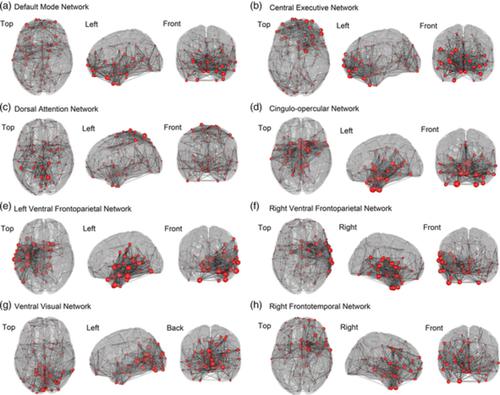当前位置:
X-MOL 学术
›
Hum. Brain Mapp.
›
论文详情
Our official English website, www.x-mol.net, welcomes your
feedback! (Note: you will need to create a separate account there.)
EEG source-space synchrostate transitions and Markov modeling in the math-gifted brain during a long-chain reasoning task.
Human Brain Mapping ( IF 3.5 ) Pub Date : 2020-05-29 , DOI: 10.1002/hbm.25035 Li Zhang 1 , John Q Gan 2 , Yanmei Zhu 3 , Jing Wang 4 , Haixian Wang 3
Human Brain Mapping ( IF 3.5 ) Pub Date : 2020-05-29 , DOI: 10.1002/hbm.25035 Li Zhang 1 , John Q Gan 2 , Yanmei Zhu 3 , Jing Wang 4 , Haixian Wang 3
Affiliation

|
To reveal transition dynamics of global neuronal networks of math‐gifted adolescents in handling long‐chain reasoning, this study explores momentary phase‐synchronized patterns, that is, electroencephalogram (EEG) synchrostates, of intracerebral sources sustained in successive 50 ms time windows during a reasoning task and non‐task idle process. Through agglomerative hierarchical clustering for functional connectivity graphs and nested iterative cosine similarity tests, this study identifies seven general and one reasoning‐specific prototypical functional connectivity patterns from all synchrostates. Markov modeling is performed for the time‐sequential synchrostates of each trial to characterize the interstate transitions. The analysis reveals that default mode network, central executive network (CEN), dorsal attention network, cingulo‐opercular network, left/right ventral frontoparietal network, and ventral visual network aperiodically recur over non‐task or reasoning process, exhibiting high predictability in interactively reachable transitions. Compared to non‐gifted subjects, math‐gifted adolescents show higher fractional occupancy and mean duration in CEN and reasoning‐triggered transient right frontotemporal network (rFTN) in the time course of the reasoning process. Statistical modeling of Markov chains reveals that there are more self‐loops in CEN and rFTN of the math‐gifted brain, suggesting robust state durability in temporally maintaining the topological structures. Besides, math‐gifted subjects show higher probabilities in switching from the other types of synchrostates to CEN and rFTN, which represents more adaptive reconfiguration of connectivity pattern in the large‐scale cortical network for focused task‐related information processing, which underlies superior executive functions in controlling goal‐directed persistence and high predictability of implementing imagination and creative thinking during long‐chain reasoning.
中文翻译:

在长链推理任务期间,数学天才大脑中的 EEG 源空间同步状态转换和马尔可夫建模。
为了揭示数学天才青少年处理长链推理的全局神经元网络的转换动力学,本研究探索了瞬时相位同步模式,即脑内源在连续 50 ms 时间窗口内持续的脑电图 (EEG) 同步稳态。推理任务和非任务空闲进程。通过功能连接图的凝聚层次聚类和嵌套迭代余弦相似性测试,本研究确定了来自所有同步器的七种通用和一种推理特定的原型功能连接模式。对每个试验的时间序列同步器进行马尔可夫建模,以表征状态间转换。分析表明,默认模式网络、中央执行网络(CEN)、背侧注意力网络、扣带盖网络、左/右腹侧额顶网络和腹侧视觉网络在非任务或推理过程中不定期地重复出现,在交互式可达转换中表现出高度的可预测性。与非天才受试者相比,数学天才青少年在推理过程的时间过程中在 CEN 和推理触发的瞬态右额颞网络 (rFTN) 中显示出更高的分数占用率和平均持续时间。马尔可夫链的统计模型表明,数学天才大脑的 CEN 和 rFTN 中有更多的自环,这表明在时间上保持拓扑结构具有强大的状态持久性。此外,有数学天赋的受试者在从其他类型的同步器切换到 CEN 和 rFTN 时表现出更高的概率,
更新日期:2020-05-29
中文翻译:

在长链推理任务期间,数学天才大脑中的 EEG 源空间同步状态转换和马尔可夫建模。
为了揭示数学天才青少年处理长链推理的全局神经元网络的转换动力学,本研究探索了瞬时相位同步模式,即脑内源在连续 50 ms 时间窗口内持续的脑电图 (EEG) 同步稳态。推理任务和非任务空闲进程。通过功能连接图的凝聚层次聚类和嵌套迭代余弦相似性测试,本研究确定了来自所有同步器的七种通用和一种推理特定的原型功能连接模式。对每个试验的时间序列同步器进行马尔可夫建模,以表征状态间转换。分析表明,默认模式网络、中央执行网络(CEN)、背侧注意力网络、扣带盖网络、左/右腹侧额顶网络和腹侧视觉网络在非任务或推理过程中不定期地重复出现,在交互式可达转换中表现出高度的可预测性。与非天才受试者相比,数学天才青少年在推理过程的时间过程中在 CEN 和推理触发的瞬态右额颞网络 (rFTN) 中显示出更高的分数占用率和平均持续时间。马尔可夫链的统计模型表明,数学天才大脑的 CEN 和 rFTN 中有更多的自环,这表明在时间上保持拓扑结构具有强大的状态持久性。此外,有数学天赋的受试者在从其他类型的同步器切换到 CEN 和 rFTN 时表现出更高的概率,











































 京公网安备 11010802027423号
京公网安备 11010802027423号